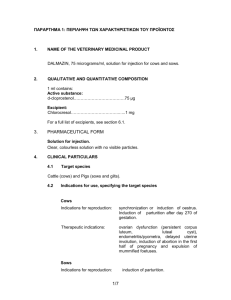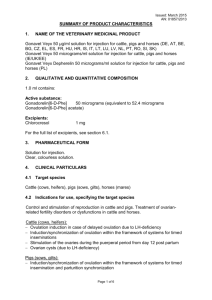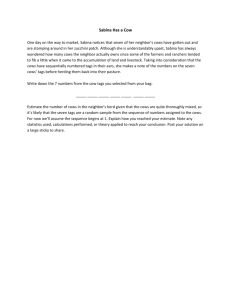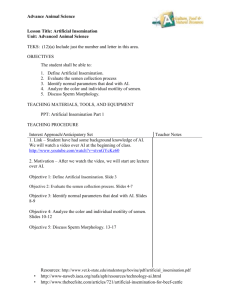View SPC - Veterinary Medicines Directorate
advertisement
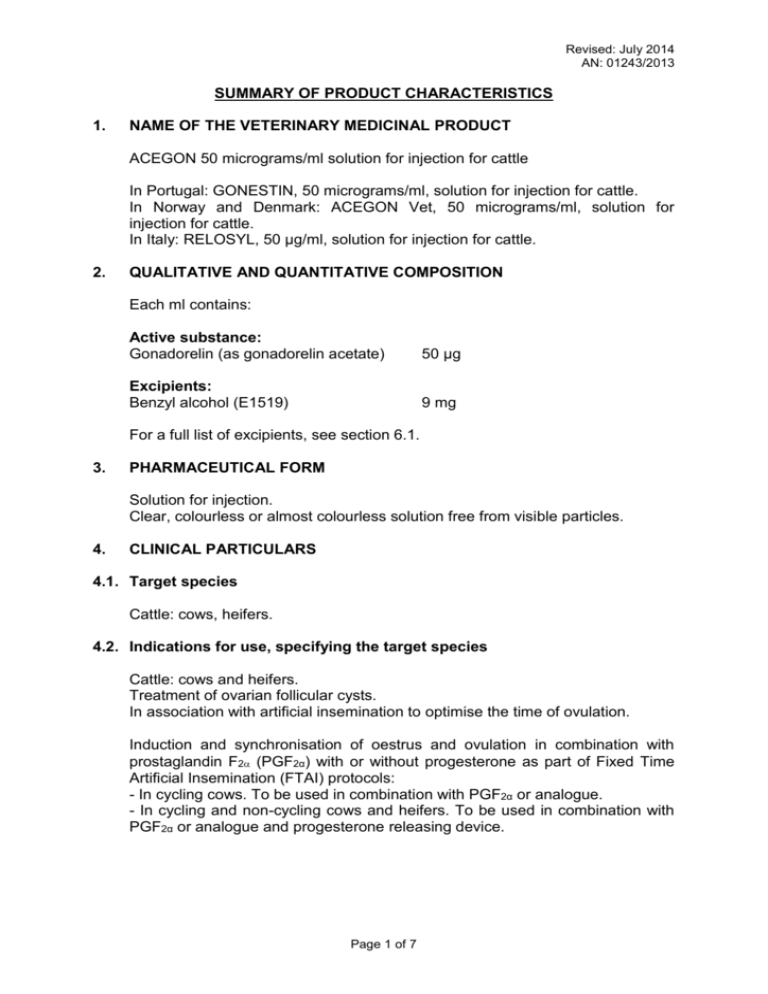
Revised: July 2014 AN: 01243/2013 SUMMARY OF PRODUCT CHARACTERISTICS 1. NAME OF THE VETERINARY MEDICINAL PRODUCT ACEGON 50 micrograms/ml solution for injection for cattle In Portugal: GONESTIN, 50 micrograms/ml, solution for injection for cattle. In Norway and Denmark: ACEGON Vet, 50 micrograms/ml, solution for injection for cattle. In Italy: RELOSYL, 50 µg/ml, solution for injection for cattle. 2. QUALITATIVE AND QUANTITATIVE COMPOSITION Each ml contains: Active substance: Gonadorelin (as gonadorelin acetate) 50 µg Excipients: Benzyl alcohol (E1519) 9 mg For a full list of excipients, see section 6.1. 3. PHARMACEUTICAL FORM Solution for injection. Clear, colourless or almost colourless solution free from visible particles. 4. CLINICAL PARTICULARS 4.1. Target species Cattle: cows, heifers. 4.2. Indications for use, specifying the target species Cattle: cows and heifers. Treatment of ovarian follicular cysts. In association with artificial insemination to optimise the time of ovulation. Induction and synchronisation of oestrus and ovulation in combination with prostaglandin F2 (PGF2α) with or without progesterone as part of Fixed Time Artificial Insemination (FTAI) protocols: - In cycling cows. To be used in combination with PGF2α or analogue. - In cycling and non-cycling cows and heifers. To be used in combination with PGF2α or analogue and progesterone releasing device. Page 1 of 7 Revised: July 2014 AN: 01243/2013 4.3. Contraindications Do not use in animals with known hypersensitivity to gonadorelin and to any excipient. 4.4. Special warnings for each target species In the treatment of cystic ovaries, the condition of ovarian follicular cysts should be diagnosed by rectal palpation revealing the presence of persisting follicular structures with a diameter over 2.5 cm and should be confirmed by the use of plasma or milk progesterone assay. The product should be administered at least 14 days after calving due to the absence of receptivity of the hypophysis before that time. For induction and synchronisation of oestrus and ovulation in Fixed Time Artificial Insemination (FTAI) protocols, the product should be administered at least 35 days after calving. The response of cows and heifers to synchronisation protocols is influenced by the physiological state at the time of treatment. Responses to treatment can vary either across herds or across cows within herds. However, the percentage of cows displaying oestrus within a given period is usually greater than in untreated cows and the subsequent luteal phase is of normal duration. For protocol that includes PGF2: To maximise conception rates of cows to be treated, the ovarian status should be determined and regular cyclic ovarian activity confirmed. Optimal results will be achieved in healthy normally-cycling cows. 4.5. Special precautions for use i) Special precautions for use in animals Animals in poor condition, whether from illness, inadequate nutrition, or other factors, may respond poorly to treatment. ii) Special precautions to be taken by the person administering the veterinary medicinal product to animals Care should be taken when handling the product to avoid selfinjection. In case of accidental self-injection, seek medical advice immediately and show the package leaflet or the label to the physician. Accidental spillage on the skin or eyes should be washed off with plenty of water. This product should be handled with care by pregnant women or women of child-bearing age that are taking contraceptives. People with known hypersensitivity to GnRH analogues, should avoid contact with the veterinary medicinal product. Page 2 of 7 Revised: July 2014 AN: 01243/2013 4.6. Adverse reactions (frequency and seriousness) None 4.7. Use during pregnancy, lactation or lay Not indicated for use during pregnancy. No contraindications have been described during lactation. 4.8. Interaction with other medicinal products and other forms of interaction None known 4.9. Amounts to be administered and administration route Intramuscular use. Treatment of ovarian follicular cysts: 100-150 micrograms of gonadorelin (as acetate) per animal (i.e. 2- 3 ml of the product per animal). If necessary, treatment can be repeated at intervals of 1-2 weeks. In association with artificial insemination to optimise the time of ovulation, improving the chances that the treated cow will become fertile: 100 micrograms of gonadorelin (as acetate) per animal (i.e. 2 ml of the product per animal). It must be administered at the same time as artificial insemination and/or 12 days after this. The following timing of injection and insemination should be followed: Injection should be performed between 4 and 10 hours after oestrus detection. An interval of at least 2 hours between the injection of GnRH and artificial insemination is recommended. Artificial insemination should be carried out in accordance with the usual field recommendations, i.e., 12 to 24 hours after oestrus detection. Induction and synchronisation of oestrus and ovulation in combination with prostaglandin F2 (PGF2α) with or without progesterone as part of Fixed Time Artificial Insemination (FTAI) protocols: The following FTAI protocols have been commonly reported in the literature: In cycling cows: Day 0: Inject 100 micrograms of gonadorelin (as acetate) per animal (2 ml of the product) Day 7: Inject PGF2α or analogue (luteolytic dose) Day 9: Inject 100 micrograms of gonadorelin (as acetate) per animal (2 ml of the product) Artificial insemination 16–20 hours later, or at observed oestrus if sooner. Alternatively: Page 3 of 7 Revised: July 2014 AN: 01243/2013 Day 0: Inject 100 micrograms of gonadorelin (as acetate) per animal (2 ml of the product) Day 7: Inject PGF2α or analogue (luteolytic dose) Artificial insemination and injection of 100 micrograms of gonadorelin (as acetate) per animal (2 ml of the product) 60–72 hours later, or at observed oestrus if sooner. In cycling and non-cycling cows and heifers: Insert intravaginal progesterone releasing device for 7-8 days. Inject 100 micrograms of gonadorelin (as acetate) per animal (2 ml of the product) at progesterone device insertion. Inject a luteolytic dose of PGF2α or analogue 24 hours prior to device removal. FTAI 56 hours after removal of the device, or Inject 100 micrograms of gonadorelin (as acetate) per animal (2 ml of the product) 36 hours after progesterone releasing device removal and FTAI 16 to 20 hours later. 4.10. Overdose (symptoms, emergency procedures, antidotes), if necessary At up to 5 times the recommended dose and in a regimen extended from one to three daily administrations, no measurable signs of either local or general clinical intolerance were observed. 4.11. Withdrawal periods Meat and offal: zero days. Milk: zero hours. 5. PHARMACOLOGICAL PROPERTIES Pharmacotherapeutic group: releasing hormones ATCVet Code: QH01CA01 Hypothalamic Page 4 of 7 hormones. Gonadotropin- Revised: July 2014 AN: 01243/2013 5.1. Pharmacodynamic properties Gonadorelin (as acetate) is a synthetic gonadorelin (“Gonadotropin Releasing Hormone” GnRH) physiologically and chemically identical to the natural gonadorelin released by the hypothalamus in mammalian species. Gonadorelin stimulates the synthesis and release of the pituitary gonadotropins, luteinizing hormone (LH) and follicle stimulating hormone (FSH). Its action is mediated by a specific plasma membrane receptor. Only 20% GnRH receptor occupancy is required to induce 80% of the maximum biological response. The binding of GnRH to its receptor activates protein kinase C (PKC) and also mitogen-activated protein kinase (MAPK) cascades which provide an important link for the transmission of signals from the cell surface to the nucleus allowing synthesis of the gonadotropin hormones. Repeat breeding may be affected by multiple factors, including feeding and husbandry practices. Also, one of the most prominent findings in repeat breeding animals is the delayed and smaller preovulatory LH surge leading to delayed ovulation. Injection of GnRH during oestrus increases the spontaneous LH peak and prevents delay in ovulation in repeat breeding animals. 5.2. Pharmacokinetic particulars Absorption After intramuscular administration in cows, gonadorelin is rapidly absorbed from the injection site, with a plasma half-life of approximately 20 minutes. Distribution An increase in the level of LH is detected thirty minutes after the administration, demonstrating fast distribution to the adenohypophysis. Metabolism The compound is rapidly metabolized into smaller inactive peptides and aminoacids. Elimination The main excretion route is renal, although a significant proportion is also excreted in expired air. 6. PHARMACEUTICAL PARTICULARS 6.1. List of excipients Benzyl alcohol (E 1519) Potassium dihydrogen phosphate Dipotassium phosphate Sodium chloride Water for injections Page 5 of 7 Revised: July 2014 AN: 01243/2013 6.2. Incompatibilities In the absence of compatibility studies, this product must not be mixed with other products. 6.3. Shelf life Shelf-life of the veterinary medicinal product as packaged for sale: 18 months Shelf-life after first opening the immediate packaging: 28 days. 6.4. Special precautions for storage Do not store above 25 ºC. 6.5. Nature and composition of immediate packaging Material of the primary container Type II colourless glass vials (6, 10, 20, 50 and 100 ml). Type I bromobutyl stoppers. Pack sizes Cardboard box containing 1 glass vial of 6, 10, 20, 50 or 100 ml with a rubber stopper and aluminium cap. Cardboard box with 10 glass vials of 6 ml with a rubber stopper and aluminium cap. Not all pack sizes may be marketed. 6.6. Special precautions for the disposal of unused veterinary medicinal product or waste materials derived from the use of such products Any unused veterinary medicinal product or waste materials derived from such veterinary medicinal products should be disposed of in accordance with local requirements. 7. MARKETING AUTHORISATION HOLDER Laboratorios SYVA S.A.U. Avda. Párroco Pablo Díez, 49-57 24010 León Spain 8. MARKETING AUTHORISATION NUMBER Vm: 31592/4005 9. DATE OF FIRST AUTHORISATION Date: 19 July 2011 Page 6 of 7 Revised: July 2014 AN: 01243/2013 10. DATE OF REVISION OF THE TEXT Date: July 2014 PROHIBITION OF SALE, SUPPLY AND/OR USE To be supplied only on veterinary prescription. For animal treatment only. 13 August 2014 Page 7 of 7
